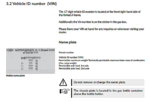It is good to learn from all of you.
my question was about the axle weight limit and the caravan weight limit according to the manufacturer we always walk the limit and it should not be so there should be a safety margin for the axle to perform at its best
Hello again Jojo,
The subject of trailer weights gets very complex to explain. It requires adopting a scientific approach to the forces and reactions involved, and you need to be clear about the technical differences between weight, mass, loads, and force, and to appreciate the strict differences between measured loads and limits in the definitions used to describe particular aspects of trailers.
Please forgive me if i'm wrong, but we know you live in Protugal, and I think I detect that English is not your native tongue, and that might make it difficult for me to present the information in a way I can be certain you will full y understand.
So I ask you to accept that both the caravan manufacturer and the chassis manufacturer are acting perfectly logically. The axle load limit must never be less than the trailers maximum trailed load capacity.
In a rather simplified way, most caravan manufacturers design a caravan and work out its maximum load bearing capacity. They then have to choose suitable axle components from a set of standardised chassis standard parts. It's highly likely their calculations will fall between two axle values. To ensure the safety of the caravan, they have to choose the nearest preferred value that is greater than their calculated figure.
In some but not all cases, the caravan manufacture may be able to allow the weight capacity of the caravan body to be increased to match the axle rating. But other construction factors may limit limit or prevent any increase. It will depend on the model of caravan involved.
As for safety margins. The manufactures have to include in their design considerations the effect of towing on the caravan. Caravans are subject to lots of different motions which produce accelerations. These act on the mass of the caravan and produce extra forces which change the loads on the components of the caravan continually. The components are designed to cope with these changes of load. These are where the margins of safety are involved.
Whilst the components must have these margins of safety, they are not available to be used for excess payload, becasue any excess load is multiplied by the effects of motion and erode the margins of safety.
I'm sorry you don't seem to have much pay load capacity in your caravan, That is one of the things you should have considered before buying the caravan.



